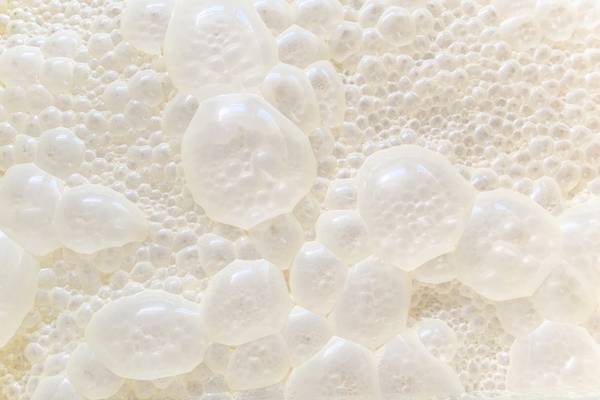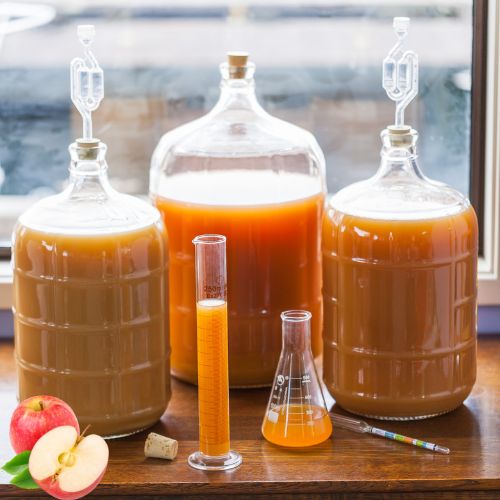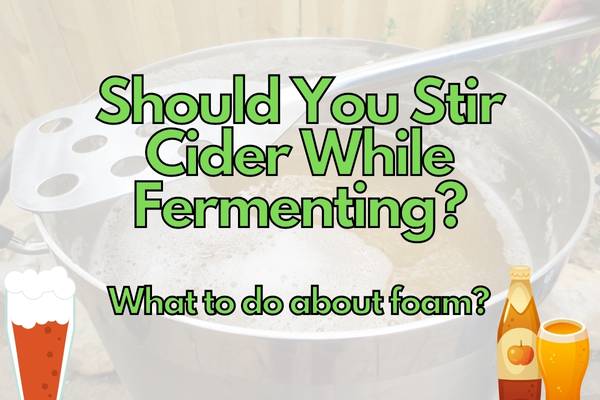If you are making cider at home, you may be wondering if you should stir it while fermenting. The answer is: it depends!
Generally, for small portions of pure apple cider (below 10 gallons), there is no need for stirring. However, for very large fermentation tanks where natural diffusion of nutrients may be limited or when other flavor-giving objects (e.g. hops, wood pieces, whole fruits, etc.) are added, there may be a need for occasional stirring.
Whereas stirring before the fermentation starts is not harmful, and is necessary for beer and many other types of brewing e.g. beer brewing to release the sugars from the grains, it is not really necessary for fruit wines and ciders where everything is already fully dissolved in a homogenous liquid.
However, stirring should always be kept at a minimum to reduce oxygen exposure towards the end of the fermentation.
The main reason for stirring during fermentation is to keep the yeast and nutrients in a homogenous suspension so the yeast can continue doing its job.
Once the fermentation is complete, you will want to minimize oxygen exposure to prevent oxidation, which can give your cider off flavors.
Do you stir after pitching yeast?
You can, but it is usually not necessary to stir the cider after pitching the yeast in. In fact, it is better to get as few objects in contact with the fresh cider as possible to avoid contamination.
I usually just pitch in the yeast directly in the fermentation tank as it will slowly hydrate and distribute itself. The produced CO2 will eventually carry the yeast cells around and make sure to redistribute nutrients and sugars for the yeast to eat.

An exception to this advice is if your yeast is clumping a lot or if your yeast is stored as hard pellets. Then, my advice is to make a small pre-culture where you dissolve the yeast using shaking or stirring in a small sterile container before pitching it into the final fermentation container!
However, if you do stir, be sure to use a clean utensil that has been sterilized in boiling water!
Should you shake fermenting cider?
No, there is no reason to shake fermenting cider! The bubbling CO2 will act to redistribute yeast and nutrients in most cases.
In contrast to many other industrial-scale microbial production processes, cider does not need oxygen and this is why periodic mixing is largely unnecessary.
The only exception would be for very large containers or when additional ingredients like sugars or sulfites are added, but here it is impractical to shake, and stirring would be preferred.
What happens if I shake my cider?
If you accidentally shake your cider while fermenting, not much will happen. Depending on the stage, the yeast will resuspend into the solution and some yeast cells may break to release nutrients and taste.

The earlier in the process you shake the fermentation, the less damage it will do. Later on, you risk dissolving a lot of dead yeast residues that would otherwise be left behind during racking.
However, as long as the brewing vessel is kept oxygen-free, no major damage is done.
Why is my apple cider foamy?
The foam on top of your apple cider and beer is sometimes called “kraeusen” and is normal during fermentation of especially wheat-containing beers.
It is caused by the release of carbon dioxide gas from the yeast cells that interact with long chains of proteins and carbohydrates in the brew. Although apple cider contains less protein than beer wort, there will always be some present (otherwise the yeast would not survive!).
Carbohydrates such as pectin in most fruits will also take a minor part in these reactions, but are slowly broken down during the process and should disappear as the fermentation moves along.

If your apple juice has been obtained using high-speed kitchen juicer or similar, there will also be lots of foam forming just from the harsh extraction process that denatures the proteins and leads to foam from the beginning.
In this case, the foam can simply be removed straight away (and tastes quite good when frozen as ice cream!).
Also, juice that has been obtained without much filtration of larger particles will contain more proteins.
So a cleaner and slower extraction process will generally lead to less foaming. But it also depends on the types of apples and yeast used.
Generally, the yeasts used for wines and champagne produce less foam than slower beer and dedicated cider yeasts.
Whereas the foam will usually disappear on its own within a few days, there are a few things you can do if you risk overflow/blowout due to excessive foam.
1. Add proteinase (protein cutting) enzyme suitable for brewing. This will break up the protein chains and split the foam apart. Proteinases are naturally found in pineapple juice and a few (non-heat treated!) drops can be added to the brew in an early stage to break up the foam.
2. Add some pectinase (pectin cutting enzyme). This will clear out the pectin to make a clearer cider but will also break up some of the long polymer chains that cause the foaming. However, this is likely to be less effective than proteinases.
3. Move your fermenter to a colder location. This will slow down the fermentation and reduce the CO2 formation that “inflates” the protein structures to form the foam. This will help to prevent overflow reactions where the foam exists through the airlock.
However, this will also slow the process of foam breakdown. So although the foam will be less severe, it might hang around for long!
4. Try gently swirling the brew in circular motions to force the foam to collapse onto the sides of the fermentation vessel. This only works with enough head space, otherwise, the foam might escape through the airlock!
5. Spray some oil on top of the foam. The oil particles will interact with the hydrophobic proteins and collapse them around the oil particles instead of expanding the foam structure. In this way the foam may collapse altogether or never form at all if used early on in the fermentation process!
It is best to use taste-neutral oil that does not go rancid too easily. For example mild olive oil or other neutral cooking oils.
Overall, it is best to experiment a little and see what works best for you and the type of cider you are making. Stirring should only be done if really necessary as it risks contamination and oxygen exposure. Otherwise, just let the CO2 do its job and the foam will eventually subside.
Conclusion
So, should you stir cider while fermenting? It depends on the situation, but generally speaking, it’s not necessary. Do be careful not to expose the cider to oxygen too much towards the end of fermentation to avoid off-flavors.
If you do feel like stirring your cider, the best time is just after pitching the yeast, as the oxygen will not damage the brew at this point. But you still need to be attentive to hygiene!
And if your cider is foamy, there are a few other things you can do to help reduce the foam, such as adding proteinase or a bit of oil, before attempting stirring or manual removal.
One exception to the rule is if you are fermenting a small batch of cider and not adding any other ingredients, there is no need to stir. But if you are fermenting a large batch or adding other ingredients, you should stir occasionally to distribute the nutrients and improve the diffusion and taste.




